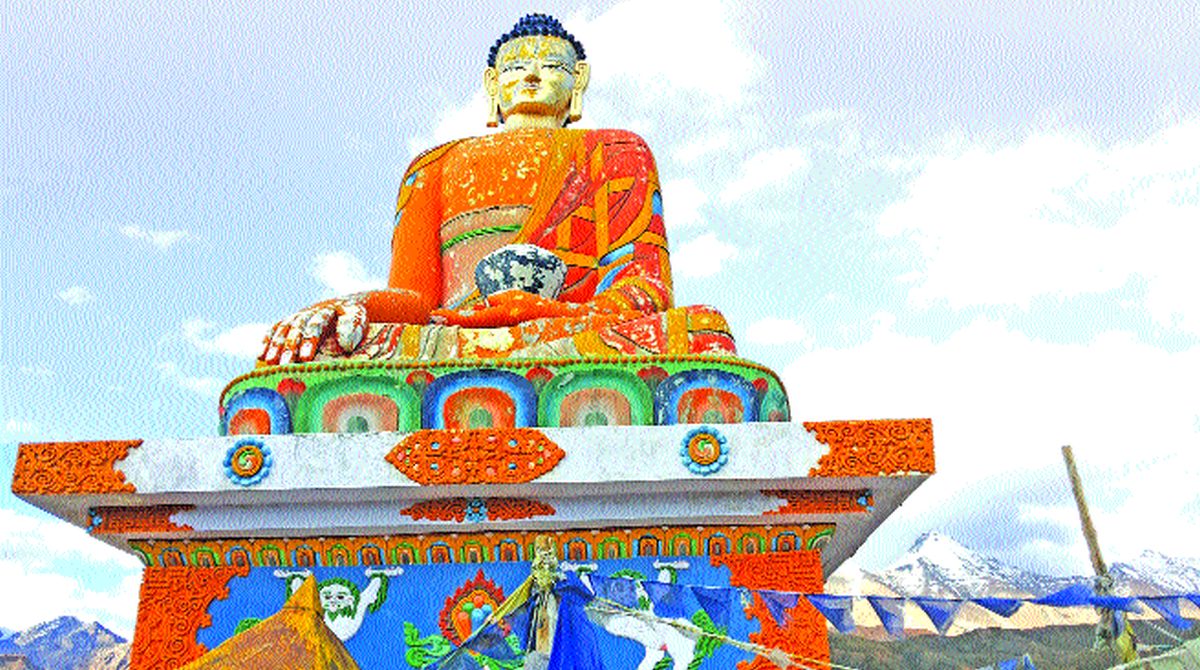A traveller in the Himalayas should undertake a journey without destination. The majestic height and length of the mountains include also a depth as deep as the Tethys Sea from which it evolved. Mysteries lie in its foliages and folds, men and myths.
As the vehicle scaled up and down along serpentine paths, after crossing the confluence of the Sutlej and Spiti rivers at Khab, a road branched from the highway to reach the village of Nako (12,014 ft), situated in the backdrop of Reo Purgyal of the Shrikhand Range, the highest mountain in Himachal Pradesh. A lake and a Tibet-oriented 11th century monastery housing iconographic art work related to Vajrayana Buddhism were the main attractions.
Moving further along the highway, I turned west from Sumdo, close to the Indo-China border and also, the gateway to the Spiti Valley. Three kilometres ahead, an unpaved road turned deep into the valley for another 12 kms after which nestled a tiny and quiet village called Gue. The Gue Gompa was located at the top of a hill overlooking the village. More than millennia old, it houses a naturally-preserved Lama Mummy, which was excavated by the Army in 1975, and placed in a tomb there.
I moved upstream along the river Spiti as hues of green on the hills began to fade out to expose naked rocks — one appreciated such mute wonders in the wild and magnificent natural museum. In between the hills, the valleys were carrying streams, drained from glaciers or springs, and boulders from the furthest hilltops. Sometimes the water cascaded down to enthral as waterfalls.
My vehicle stopped for a night halt at Tabo, a small town on the bank of Spiti, surrounding a thousand-year old architectural marvel monastery complex on a flat ground having a plethora of mud statues and wall paintings, similar to those in the Ajanta and Ellora caves but they were mostly worn out by time. Tabo is also known as the “Ajanta of the Himalayas”.
In the main temple, Indo-Tibetian fusion art is exhibited. There are nine main temples and 23 chortens besides a monk’s and nun’s chamber. The Tabo Gompa is second in importance to the Tholing Gompa in Tibet. It is an advanced centre of Buddhist learning and priceless collections of manuscripts and thangkas (scroll paintings) are kept there. On the sheer-cliff above the enclaves are a series of caves, which are used as dwelling units by the monks and include an “Assembly Hall”. Hilltops are crowned with stratified rocks and slopes with folded strata while the Spiti meanders in the low valleys. Wild colourful flowers on brownish grey rocks break the monotony. Further upstream from Tabo, conglomeratic sandstones get weathered to form hundreds of individual pillars pointing upwards and force travellers to halt and enjoy the view of needle rock formations. Nature is never a miser when it comes to making sculptures!
Overlooking Spiti, large folds and faults on hill slopes attract travellers and lure geologists to unfold its history. A rocky road diverted into Dhankar and its Monastery. It is situated above Sichling on the left bank of Spiti that widens its valley by braiding. A picturesque view incites myriad emotions. Dhankar was once the capital of Spiti, which was later shifted to Kaza.
Travelling along the Spiti, small villages can be found nestling in the valleys, people working hard to cultivate grains and vegetables, trekking thousands of feet up and down the hills, sometimes with loads, for their livelihood and schooling but they are still so polite and gentle. They have learned from nature to live with hardships and fight for survival.
Moving on, Langza once a heaven for fossil collectors has now become barren. There is a post office nearby at Hikkim, which holds the world record for being the highest at 14,567 ft. Tourists, for whom a post office is another kind of fossil treasure, flock into the small hamlet to send letters. Komic (14,830 ft) holds the distinction of being the highest motorable village in the world. These areas remain under several feet of thick ice for seven months in a year and still they live happily. Wonders are boundless indeed!
I visited the 11th century multi-storeyed monastery and religious training centre for Lamas at Kye. Paintings and murals decorate the walls. It bears the testimony of multiple attacks by humans and nature. The Spiti river, large meadows and the surrounding glacial mountain range collectively decorate Lossar, the last village of the valley. The local population depends more on handcrafts and tourism for their livelihood and less on agriculture. The night was nearly freezing and drenched by rains.
I left early the next morning amid rains and crossed Kunjum Pass, the highest motorable pass (15,060 ft) in Himachal Pradesh and the exit point of Spiti Valley to enjoy a mysterious view of Chadrataal (14,200ft). The danger of rocks falling and landslides was at every curve and Mahesh, my guide and driver, was always alert even for shooting stones due to quick steps of blue sheep on the slopes above. The Spiti region, also known as “Little Tibet” because its Buddhist culture, reveals its bounty at every valley.










